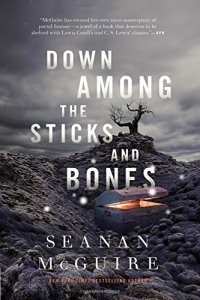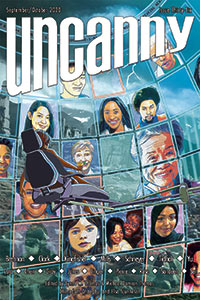Russell Letson Reviews Beyond the Outposts by Algis Budrys
 Beyond the Outposts: Essays on SF and Fantasy 1955-1996, Algis Budrys (Ansible Editions 978-0-244-56705-7, $22.50, tp, 378pp) April 2020.
Beyond the Outposts: Essays on SF and Fantasy 1955-1996, Algis Budrys (Ansible Editions 978-0-244-56705-7, $22.50, tp, 378pp) April 2020.
As I never tire of mentioning in these pages, I have always been a book-review junkie, so it should not be surprising that much of my sense of science fiction – not just which books were worth pursuing but how the whole genre works – was formed less by scholars or official-canonical literary critics than by reviewers who were often also practitioners: Judith Merril, Joanna Russ, Damon Knight, James Blish/William Atheling, Jr., and, over a nearly 30-year stretch in Galaxy and F&SF, Algis Budrys. Like Knight and Blish, and later John Clute, Gary K. Wolfe, and Judith Merril, some of Budrys’s reviews made it out of periodical limbo and into book form: in 1985, Southern Illinois University Press produced Benchmarks: Galaxy Bookshelf. A second volume was planned but never completed, until David Langford (proprietor of internet news site/newszine Ansible) took up the task and compiled three posthumous follow-up collections in which the Benchmarks columns are Continued, Revisited, and Concluded.
And now what must be the completion of this expanded preservation project: Beyond the Outposts: Essays on SF and Fantasy 1955-1996. The part of the title before the colon refers to five essays originally collected in Outposts: Literatures of Milieux (1997), but the rest of its 45 items include a wide range of reviews, introductions, occasional essays, extended essays, memoirs, and columns, gathered from a variety of sources (including the pages of this magazine). Most date from the 1980s, but they reach back as far as a 1955 fanzine piece, “Or Thwim”, that opens the book and addresses, without quite naming it as such, the tension between dulce and utile.
Budrys’s prose, like the thinking it outlines, is meticulous, concentrated, often ironic, and always relentless. Confronting such a concentrated solution of analytical thinking and insight, formulated with such fierce precision, is both exhilarating and exhausting – the writing is allusive and playful and hyperaware and reflexive and reflective. And it’s funny. This is not, however, a book that you sit down and read straight through – it is not only long (378 pages) but miscellaneous, unified not by structure but by repeated attempts to organize and map and make sense of significant reaches of critical and literary territory, to ask, “What is science fiction, that we should be mindful of it?”
Answers to that question reside primarily in four of the longer pieces: “Paradise Charted” (1980), “Pulp!” (1982), “Non-Literary Influences on Science Fiction” (1983), and “Literatures of Milieux” (1984). Taken together, we get a Budrysian theory of SF as a literary-intellectual and commercial-entertainment enterprise with a very particular history. That theory is sometimes salted with evocative, if quirky terminology – stef, Modern (of science fiction), coil-winder, superscience – that characterizes and categorizes features and periods of the field. The personal is often mixed with the professional – appropriate, since Budrys lived a good bit of the history he recounts, knew the personalities, and worked under the conditions of creation, production, and distribution that he outlines as shaping the literature.
“Paradise Charted” ranges across literary taxonomy, publishing/marketing history, the sociology of fandom, and genre labeling, among other things, with special attention to the roles of Hugo Gernsback and John W. Campbell and the dominance, for a period, of the latter. There are also thumbnail portraits of representative and artistically significant writers of what he calls Modern SF: Fritz Leiber, the Henry Kuttner/C.L. Moore/Lewis Padgett amalgam, James Blish, et al. The accompanying hand-drawn chart (made for the original appearance in uptown journal TriQuarterly) offers a kind of bird’s-eye view of the historico-developmental processes that led to the “stef” family, with names named and circles and arrows indicating kinships and connections.
“Literatures of Milieux” employs an historical overview to address problems of definition and the distinction between or similarities of SF and fantasy. It accepts and extends Brian Aldiss’s identification of Frankenstein as an ur-text and tracks the attempts of Reginald Bretnor, Robert A. Heinlein, Damon Knight, Brian Aldiss, et al. to nail down a neat taxonomic scheme. But the role (or non-role) of the “science” part of SF’s initials is not quite as advertised – instead, “the apparently most pragmatic and rational of literature has an irrational basis.” Despite the detail with which it is worked out, this is the least surprising of the big essays, since much of its ground has been thoroughly trod by armies of other commentators. It does, though, contain the memorable summary judgment that “science fiction is a marketing term. It may be congruent with a literature to which one might give the same name, or it may not. But as normally used, it is a brand name on a box….”
“Pulp!” is perhaps the most idiosyncratic of these long essays, based on a (to my mind) rather odd distinction between “pulp” and “slick” as modes of fiction first, rather than as kinds of paper or combinations of publishing-practice, marketplace, and readership expectation, which are the determining forces in the other essays. Nevertheless, push past that odd presentational hook and there’s the now-familiar take on the way audiences, editors, writers, and production/distribution channels converge to produce a literature.
If I had to point to a single reason to get this book, it would be “Non-Literary Influences on Science Fiction” (1982/1983), a long essay that provided the first (to my recollection) view available to literature students of the workaday realities of the production of magazine fiction. (Outside of those who focused on the long-vanished worlds of, say, Dickens or Dr. Johnson, anyway.)
Scholars founding theses on the content of older science fiction stories should be aware that the content rarely derives from purely literary factors. Furthermore, many of the interventions between the manuscript and the printed page are not editorial in the usual sense, but are essentially mechanical…. These and other impositions of this general sort have frequently been preserved in subsequent anthologizations from the original magazine pages, and exist now as snares for the reader seeking literary meanings in every word of the text.
Ironically enough, the book publication of this essay was subjected to enough editorial intervention by its publisher to warrant a long post-mortem piece by divers hands (reprinted in A Budrys Miscellany, see Note below).
I would argue that Budrys’s strongest contribution to SF/F scholarship is this awareness of how art and commerce rub up against each other, how fiction is produced and packaged and delivered to audiences – a shop-floor viewpoint that recognizes the material as well as the aesthetic/intellectual components of the process. Of the “development of modern SF forms,” Budrys writes, “what is crucial is that it did happen in the mass market” (“New World in the Morning”, 1988). The other side of this hands-on approach shows up in the pieces that examine the writer-as-craftsman: reflections on the making of Rogue Moon or the stories in his collections; “Writing Science Fiction and Fantasy”; or the 17 “On Writing” columns for Locus. It’s not all nuts and bolts, though. The last of these advises that the prospective writer
should coldly for your own future sake be damned sure you especially want to be a writer, and if a writer, what kind. The world is full of journalists, essayists, tech manualists, brochure writers, ad writers, publicity flacks, poets, poetasters, and Irving Wallace. Do you suppose they each stood where you are standing, made a choice, and went unerringly toward their goals? Go look at them – what do you suppose scarred them so? And these are the successes….
Elsewhere there are personal recollections of the jobs and the people (for example, an affectionate, evocative, and even poetic homage to Gene Wolfe), observations of popular-culture phenomena (Star Wars gets two detailed looks), and meditations on the relationship of SF to general literary culture. “The Ideas of Mary McCarthy” (1981), for example, connects notions about the mainstream novel tradition, Napoleon, and the Two Cultures. I particularly enjoyed “The Revenge of the Empire” (1984), which offers a spot-on explanation of the differences between the original Star Wars movie and its first two sequels, summed up, to my mind, in one line: “George Lucas is the man who filmed a Planet story” – which is to say, an adventure tale that could have appeared in the glory days of Planet Stories. This piece also includes another homage, this time to Leigh Brackett, who played an important role in that pulp world. There are pieces of inside-baseball/personal-memoir interest: the “story which I guess now can be told” of how Budrys’ review of Stranger in a Strange Land did not appear in Galaxy, or recollections of Theodore Cogswell, or of the beginnings of the Milford conferences, or of working in the now-vanished magazine world as writer, editor, or reviewer.
From all this emerges a kind of literary-vocational autobiography, distributed out of order across the book’s bits and pieces. I suppose the ebook version would allow one to cut and paste together a sequential account, but there’s a kind of pleasure in watching Budrys reveal this or that aspect of himself as he treats the materials that are the official topics of discussion – books and stories and movies and other writers and the machineries of imagination and industry, all of which are amenable to disassembly and analysis. AJ is gone now, as is much of the publishing world that shaped him and the field that he clearly loved. Beyond the Outposts might not be an official memoir, but I’m keeping it shelved next to Damon Knight’s The Futurians, Frederik Pohl’s The Way the Future Was, Harry Harrison! Harry Harrison!, and the rest of the accounts of those shaggy magazine days.
Note: For an even deeper dive into this under-appreciated writer and critic, there’s also A Budrys Miscellany: Occasional Writing 1954-2000, a free PDF that David Langford calls “a spinoff from, or pendant to” the collection officially under consideration here. It includes fanzine writing, short reviews, and the editorials for the Budrys-edited-and-published Tomorrow Speculative Fiction. (It’s one of the downloadable TAFF freebies, with a bit of nudge to contribute to the TransAtlantic Fan Fund.)
Russell Letson, Contributing Editor, is a not-quite-retired freelance writer living in St. Cloud, Minnesota. He has been loitering around the SF world since childhood and been writing about it since his long-ago grad school days. In between, he published a good bit of business-technology and music journalism. He is still working on a book about Hawaiian slack key guitar.
This review and more like it in the August 2020 issue of Locus.
 While you are here, please take a moment to support Locus with a one-time or recurring donation. We rely on reader donations to keep the magazine and site going, and would like to keep the site paywall free, but WE NEED YOUR FINANCIAL SUPPORT to continue quality coverage of the science fiction and fantasy field.
While you are here, please take a moment to support Locus with a one-time or recurring donation. We rely on reader donations to keep the magazine and site going, and would like to keep the site paywall free, but WE NEED YOUR FINANCIAL SUPPORT to continue quality coverage of the science fiction and fantasy field.








